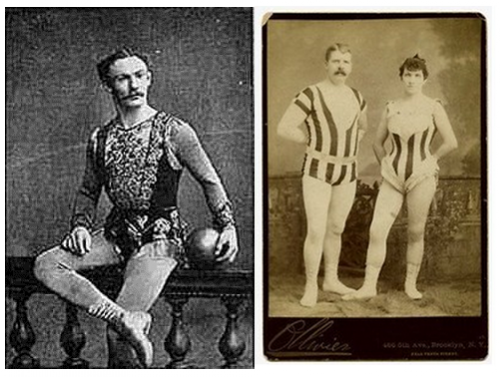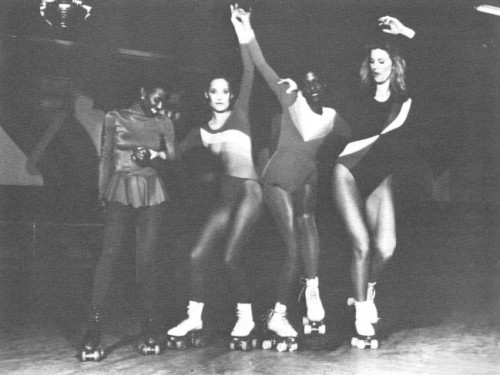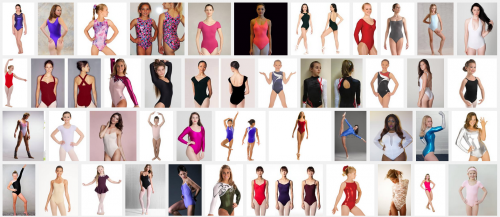I am so grateful to reader Emma Farais for recommending that I look into the history of the leotard. It was invented by — well, who else — Jules Léotard.
Born in 1842, Jules grew up to be an acrobat. He is credited with inventing trapeze and performed with French circuses. He invented and then began performing in leotards and he was a big hit. According to the Victoria and Albert Museum:
The original leotard was an all-in-one knitted suit. It allowed freedom of movement, was relatively aerodynamic and there was no danger of a flapping garment becoming entangled with the ropes. Even more importantly, it showed off his physique to its best advantage.
He was a huge hit with the ladies. Alas, he died at age 28. Or 32, depending on the source.
But the leotard lived on. Leotards were adapted for women, but the form and function were similar. Think vintage muscle men and women.
Jules Léotard, circa 1850 (left); Circus Strong Man and Women, circa 1890 (right):
Male dancers, athletes, and thespians wore leotards well into the ’70s. Eventually, though, disco happened. Disco fashion emphasized leotard fashion for women, as this roller disco shot from the Empire Rollerdome reveals:
(Oh, to be a roller disco queen in ’70s Brooklyn. Sigh.)
Men eventually abandoned leotards as they became increasingly popular with women. We saw the same pattern, of course, with high heels and cheerleading: male flight from feminizing fashions and activities. The more women wore leotards, the less men wore them. Eventually, companies stopped making leotards for men altogether.
To the disappointment of all the (het) ladies, I’m sure.
Today, a Google Image search for leotard returns all ladies. Mostly girls, in fact. Not a guy in the bunch:
I can only think of two arenas in which leotards for men still hold sway: wrestling and professional weight lifting. And, now I guess we know why.
Lisa Wade, PhD is an Associate Professor at Tulane University. She is the author of American Hookup, a book about college sexual culture; a textbook about gender; and a forthcoming introductory text: Terrible Magnificent Sociology. You can follow her on Twitter and Instagram.


Comments 20
mr_subjunctive — February 3, 2015
Born in 1842, Jules grew up to be an acrobat.
Jules Léotard, circa 1850 (left)
That's . . . quite an impressive moustache, for an 8-year-old.
Dromeda — February 3, 2015
The onesie version of the leotard, the sentai suit, /is/ becoming more popular with men, however.
Bill R — February 3, 2015
While the specific clothes men and women wear is a matter of social custom and varies over time and geography, it seems that the desire of men and women to distinguish themselves from each other by their attire is rooted in nature.
You will catch me in my leotards (or as I call them, bike pants) when the temps drop below 40 degrees. Most comfortable thing to wear too!
Ruben Anderson — February 3, 2015
As a man who tries to do trapeze whenever possible, I am a giant fan of the leotard, paired with tights. Spandex onesies need not apply.
Umlud — February 4, 2015
You forgot one other group that wear leotards: superheroes! ;)
Why Only Women, Wrestlers, and Weight Lifters Wear Leotards. | Koolnews Blog — February 6, 2015
[…] Source: thesocietypages.org […]
Dan Ruth — February 7, 2015
Men's gymnastics is another arena where the leotard also still holds sway. But it's interesting to see the decline of men's gymnastics as the sport more and more has become associated with women. Is that, in part, because of the cultural norms associated with femininity (and/or homosexuality), like pointing one's toes and wearing "leos" (as they're often affectionately called)?
There's another post...
Madison Bannon — March 13, 2015
And rowers!
Who wears leotards and why? | Fat Rabbit's Delight — March 20, 2015
[…] An interesting read on why almost everyone who wears a leotard these days is a little girl. […]
Lucas Pendant — December 15, 2015
Hahaha loved the comments.
if you're looking for leotards in Aussie, check this out http://www.energetiks.com.au/mens-leotards/ they're quite comfortable ;)
Bryce — December 5, 2018
Male gymnasts also wear leotards (technically “singlets” since they have no sleeves) with a pair of stirrup pants or shorts (depending on the apparatus) covering the bottom portion of the leotard (presumably for modesty). The reason why men’s gymnastics is not as popular as women’s gymnastics in the US anyway is because traditionally American women have been much more successful in the sport (having many world and Olympic champions who end up on Wheaties boxes).
The US has only ever had one male gymnast (Paul Hamm) who was ever a World or Olympic champion in the sport. But it’s had a dozen women’s all-around champions (Mary Lou Retton, Kim Zmeskal, Shannon Miller, Carly Patterson, Chellsie Memmel, Shawn Johnson, Nastia Liukin, Bridget Sloan, Jordyn Wieber, Gabby Douglas, Simone Biles, Morgan Hurd). Yet in countries like Japan, China, and Russia, men dominate in gymnastics, making it a much more popular sport there.
Andy — February 4, 2019
Men use leotards also as underwear even if not so many of them do it. They believe leotards are only for women. ONce they try them anyway they adopt them immediately as they are very comfortable for men. I use them normally
Bill — November 3, 2019
Anybody looks better in a leotard and leggings. Anybody.
Giles — March 19, 2020
Plenty of men wear leotards - wrestlers, runners, rowers, cyclists, gymnasts and ballet dancers.
But with the exception of the last two, they don't call them leotards. Interestingly, it's not the garment that has become so exclusively gendered: it's the word.
Martin — June 3, 2020
Maybe it is not the common fashion, but I love to use leotards as a normal, good looking sports- and homewear.
https://www.flickr.com/photos/50405213@N07/with/49948613542/
Leotards are so practically and comfortable to wear and so:
Why not for men ?!
Aaron Bredon — September 2, 2021
@Bryce Hamm - you seem to forget Kurt Thomas, who won 3 World Championships in Gymnastics and probably would have gotten an Olympic Gold medal except for the 1980 boycott.
Jovie Louise — January 27, 2025
Leotards offer comfort, flexibility, and freedom of movement, which is why they’re favored by women, wrestlers, and weightlifters. I believe vintage 80s clothing their practicality and form-fitting design support optimal performance in these physically demanding activities. However, the cultural perception around leotards is often gendered, despite their universal utility in athletics.